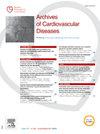Study of the BRAF-T599R hiPSC line, a new model for impaired cardiac relaxation associated with hypertrophic cardiomyopathy?
IF 2.2
3区 医学
Q2 CARDIAC & CARDIOVASCULAR SYSTEMS
引用次数: 0
Abstract
Introduction
Mutations in the BRAF gene are associated with an upregulation of the MAPK pathway and often leads to hypertrophic cardiomyopathies (HCM). HCM is characterised by an increase in cardiomyocyte size, resulting in left ventricular hypertrophy and impaired myocardial relaxation in patients. Specifically, the BRAF T599R mutation is known to contribute to the development of RASopathies in patients; however, the effects of this mutation on cardiac relaxation have not been thoroughly investigated. Additionally, we have previously identified hsa-miR-548v as a positive regulator of relaxation velocity accompanied by a large decrease of ANKRD1 expression.
Objective
We aim to characterise human BRAF T599R cardiomyocytes. Additionally, we will assess changes in ANRKD1 expression and evaluate the contraction/relaxation cycles in the mutant cardiomyocytes derived from human induced pluripotent stem cells (hiPSC-CMs).
Method
The BRAF T599R hiPSC line was produced using CRISPR/Cas9 genome editing. We characterised the hiPSC-CMs using Western blot analysis on both total and fractionated cells, confocal immunofluorescence, and video microscopy on micro-engineered cardiac tissues.
Results
The mutant hiPSC-CMs an increased activation of the MAPK pathway, along with elevated expression levels of ANKRD1. The mutant hiPSC-CMs displayed increased cell size and a higher density of filamentous actin and titin networks. Following cell fractionation, we observed that ANKRD1 was overexpressed both in the nucleus (indicating transcription factor activity) and in the cytoplasm (as a sarcomeric protein) of the mutant cells. Additionally, the mutant engineered-cardiac tissues demonstrated impaired amplitude, as well as decreased contraction and relaxation velocities when compared to isogenic control tissues. After transfecting with hsa-miR-548v, the amplitude, contraction, and relaxation velocities of the mutant-engineered cardiac tissues significantly improved. Moreover, ANKRD1 expression was notably decreased in both the nucleus and the cytoplasm of the mutant hiPSC-CMs.
Conclusion
The BRAF T599R hiPSC-CMs exhibit hypertrophic cell characteristics and altered contraction and relaxation cycles compared to their isogenic control hiPSC-CMs. Additionally, these cells show higher levels of both nuclear and cytoplasmic ANKRD1. However, transfection with hsa-miR-548v reverses this increase in ANKRD1 expression. This reduction in ANKRD1 is associated with improved contraction and relaxation velocities in engineered cardiac tissue.
肥厚性心肌病相关心脏舒张受损新模型BRAF-T599R hiPSC系的研究
BRAF基因突变与MAPK通路上调相关,常导致肥厚性心肌病(HCM)。HCM的特征是心肌细胞大小增加,导致患者左心室肥厚和心肌松弛受损。具体来说,已知BRAF T599R突变有助于患者RASopathies的发展;然而,这种突变对心脏松弛的影响尚未得到彻底的研究。此外,我们之前已经发现hsa-miR-548v是弛豫速度的正调节因子,伴随着ANKRD1表达的大幅下降。目的研究人类BRAF T599R心肌细胞的特征。此外,我们将评估ANRKD1表达的变化,并评估来自人类诱导多能干细胞(hiPSC-CMs)的突变心肌细胞的收缩/舒张周期。方法采用CRISPR/Cas9基因组编辑技术构建BRAF T599R hiPSC细胞系。我们使用Western blot分析总细胞和分离细胞,共聚焦免疫荧光和视频显微镜对微工程心脏组织进行表征。结果突变的hiPSC-CMs增加了MAPK通路的激活,同时ANKRD1的表达水平升高。突变的hiPSC-CMs显示细胞大小增加,丝状肌动蛋白和titin网络密度更高。在细胞分离后,我们观察到ANKRD1在突变细胞的细胞核(表明转录因子活性)和细胞质(作为一种肉瘤蛋白)中都过表达。此外,与等基因对照组织相比,突变的工程心脏组织表现出振幅受损,收缩和松弛速度下降。转染hsa-miR-548v后,突变工程化心脏组织的振幅、收缩和弛豫速度显著改善。此外,突变体hiPSC-CMs的细胞核和细胞质中ANKRD1的表达均显著降低。结论与等基因对照hiPSC-CMs相比,BRAF T599R hiPSC-CMs表现出肥厚细胞特征,收缩和舒张周期发生改变。此外,这些细胞的细胞核和细胞质ANKRD1水平均较高。然而,转染hsa-miR-548v可逆转ANKRD1表达的增加。这种ANKRD1的减少与工程心脏组织收缩和舒张速度的改善有关。
本文章由计算机程序翻译,如有差异,请以英文原文为准。
求助全文
约1分钟内获得全文
求助全文
来源期刊

Archives of Cardiovascular Diseases
医学-心血管系统
CiteScore
4.40
自引率
6.70%
发文量
87
审稿时长
34 days
期刊介绍:
The Journal publishes original peer-reviewed clinical and research articles, epidemiological studies, new methodological clinical approaches, review articles and editorials. Topics covered include coronary artery and valve diseases, interventional and pediatric cardiology, cardiovascular surgery, cardiomyopathy and heart failure, arrhythmias and stimulation, cardiovascular imaging, vascular medicine and hypertension, epidemiology and risk factors, and large multicenter studies. Archives of Cardiovascular Diseases also publishes abstracts of papers presented at the annual sessions of the Journées Européennes de la Société Française de Cardiologie and the guidelines edited by the French Society of Cardiology.
 求助内容:
求助内容: 应助结果提醒方式:
应助结果提醒方式:


